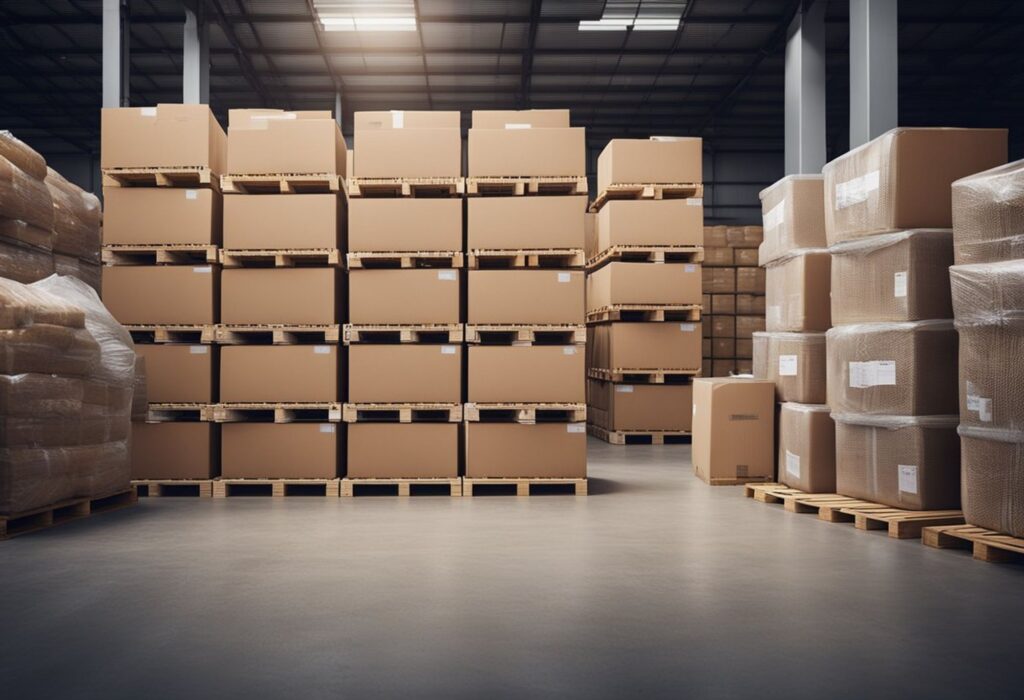
2024-07-09,
14:58:30
How to Source Eco-Friendly Products
 By Buyamia
By BuyamiaA Guide for Conscious Consumers
Companies and consumers alike are becoming more aware of the impact their actions have on the environment. As a result, there has been a growing demand for eco-friendly products. However, sourcing these products can be challenging, as it requires careful evaluation of suppliers and materials, as well as consideration of logistics and packaging.

Understanding eco-friendly products is the first step in sourcing them. Eco-friendly products are those that are made with sustainable materials and processes, and have a minimal impact on the environment throughout their lifecycle. They are often made with renewable resources, such as bamboo or recycled materials, and are designed to be reusable or biodegradable.
To source eco-friendly products, it is important to evaluate suppliers based on their commitment to sustainability. This includes assessing their environmental policies, certifications, and track record. It is also important to consider the materials and production processes used, as well as the logistics and packaging involved in getting the product to market. By taking a holistic approach to sourcing, businesses can ensure that they are offering truly eco-friendly products to their customers.
Key Takeaways
- Understanding what makes a product eco-friendly is the first step in sourcing them.
- Evaluating suppliers based on their commitment to sustainability is crucial.
- Considering the entire product lifecycle, from materials and production to logistics and packaging, is necessary for sourcing truly eco-friendly products.
Understanding Eco-Friendly Products
Definition and Importance
Eco-friendly products are those that have been designed and manufactured with minimal harm to the environment. They are made using sustainable materials and processes that reduce pollution, waste, and energy consumption. These products are important because they help to protect the environment and promote sustainability.
Eco-friendly products are becoming increasingly popular as people become more aware of the impact their choices have on the environment. Consumers are looking for products that are eco-friendly and sustainable, and companies are responding by offering a wide range of products that meet these criteria.
Environmental Impact Assessment
To determine whether a product is eco-friendly, an environmental impact assessment is often conducted. This assessment evaluates the product’s impact on the environment throughout its entire lifecycle, from production to disposal.
The assessment takes into account factors such as the materials used to make the product, the energy consumed during production, and the amount of waste generated during manufacturing and disposal. It also considers the product’s impact on air and water quality, as well as its potential to contribute to climate change.
By conducting an environmental impact assessment, companies can identify areas where they can improve their products to make them more eco-friendly. This can include using renewable materials, reducing energy consumption, and minimizing waste.
Overall, understanding eco-friendly products is important for consumers who want to make sustainable choices and for companies that want to reduce their environmental impact. By choosing eco-friendly products, consumers can help to protect the environment and promote sustainability.
Evaluating Suppliers
When it comes to sourcing eco-friendly products, evaluating suppliers is a crucial step. Here are two important factors to consider when evaluating suppliers:
Certifications and Standards
One way to evaluate suppliers is to look for certifications and standards that indicate their commitment to sustainability. For example, the Forest Stewardship Council (FSC) certification indicates that a supplier’s wood products come from responsibly managed forests. Similarly, the Global Organic Textile Standard (GOTS) certification indicates that a supplier’s textile products are made from organic materials and meet environmental and social criteria.
Sustainability Practices
In addition to certifications and standards, it’s important to evaluate a supplier’s sustainability practices. This can include their use of renewable energy, waste reduction efforts, and water conservation practices. Some suppliers may also have a sustainability report or other documentation that outlines their sustainability practices and goals.
When evaluating suppliers, it’s important to ask questions and gather information to ensure that they meet your sustainability criteria. This can include asking about their supply chain, their environmental impact, and their social responsibility practices. By carefully evaluating suppliers, you can ensure that you are sourcing eco-friendly products from responsible and sustainable sources.
Materials and Production

Renewable Resources
Sourcing eco-friendly products often means looking for materials that are renewable and sustainable. Renewable resources are those that can be replenished naturally over time, such as bamboo, cork, and hemp. These materials are often preferred over non-renewable resources like oil and gas, which are finite and have a significant impact on the environment.
Bamboo, for example, is a fast-growing grass that can be harvested every three to five years without harming the plant. It is a popular choice for products like furniture, flooring, and clothing. Cork is another renewable resource that can be harvested from the bark of cork oak trees without harming the tree. It is a popular choice for flooring, insulation, and wine bottle stoppers. Hemp is a versatile crop that can be used to make everything from clothing to paper and is known for its durability and sustainability.
Recycled and Upcycled Materials
Another way to source eco-friendly products is to look for materials that have been recycled or upcycled. Recycled materials are those that have been processed and reused, while upcycled materials are those that have been transformed into something new and useful.
Recycling materials like plastic, glass, and metal can help reduce waste and conserve resources. Recycled plastic, for example, can be used to make everything from clothing to furniture. Upcycling materials like old furniture, clothing, and accessories can give them new life and prevent them from ending up in landfills.
When sourcing products made from recycled or upcycled materials, it is important to ensure that they are of high quality and meet safety standards. It is also important to consider the production process and the impact it has on the environment.
Overall, sourcing eco-friendly products requires careful consideration of the materials and production processes used. By choosing renewable, recycled, and upcycled materials, consumers can help reduce waste, conserve resources, and support sustainable practices.
Logistics and Packaging

Reducing Carbon Footprint
One of the most significant ways to source eco-friendly products is to reduce the carbon footprint of the logistics and packaging. Companies can achieve this by using environmentally friendly packaging materials and optimizing their logistics to reduce emissions. According to DHL, sustainable packaging has the lowest possible impact on the environment. This is achieved by limiting packaging waste, using recyclable or biodegradable materials, and utilizing renewable energy sources.
Bulk-buying packaging materials is another way to reduce the carbon footprint. Ordering larger consignments reduces the number of deliveries and, therefore, the emissions involved in bringing the materials to the company. Companies can also partner with logistics providers that offer environmentally friendly shipping solutions, such as DHL’s GoGreen Plus program, which utilizes alternative fuels and carbon offsetting.
Biodegradable and Reusable Packaging
Another way to source eco-friendly products is to use biodegradable and reusable packaging. Biodegradable packaging materials, such as those made from plant-based materials like cornstarch or sugarcane, decompose naturally and do not harm the environment. Reusable packaging, such as glass jars or metal tins, can be used multiple times, reducing waste and the need for new packaging materials.
Companies can also implement reverse logistics and recycling systems to minimize waste sent to landfills. By collecting, sorting, and recycling packaging materials, products, and other waste generated in logistics operations, companies can minimize their environmental impact.
In conclusion, reducing the carbon footprint of logistics and packaging and using biodegradable and reusable materials are two effective ways to source eco-friendly products. Companies should also partner with logistics providers that offer environmentally friendly shipping solutions and implement reverse logistics and recycling systems to minimize waste.
Product Lifecycle
When sourcing eco-friendly products, it is important to consider the entire product lifecycle. This includes the sourcing of raw materials, manufacturing, distribution, use, and end-of-life disposal. By examining each stage of the lifecycle, it is possible to identify areas where improvements can be made to reduce the environmental impact of the product.
Durability and Longevity
One way to reduce the environmental impact of a product is to ensure it is durable and long-lasting. This means designing products that are made from high-quality materials and are built to withstand regular use. By creating products that are durable, it is possible to reduce the need for frequent replacements, which can lead to a significant reduction in waste.
End-of-Life Disposal
Another important consideration when sourcing eco-friendly products is the end-of-life disposal. This includes the proper disposal of the product at the end of its useful life. One way to reduce the environmental impact of a product is to design it with end-of-life disposal in mind. This means creating products that are easy to recycle, reuse, or repurpose.
In addition, it is important to consider the materials used in the product. By choosing materials that are biodegradable or compostable, it is possible to reduce the environmental impact of the product at the end of its life. This includes materials such as bamboo, hemp, and organic cotton.
Overall, by considering the product lifecycle when sourcing eco-friendly products, it is possible to identify areas where improvements can be made to reduce the environmental impact. This includes designing products that are durable and long-lasting, as well as creating products that are easy to recycle, reuse, or repurpose at the end of their useful life.
Consumer Education
Consumer education is an essential aspect of promoting eco-friendly products. It is important to educate consumers on the benefits of using eco-friendly products and how they can make a difference in the environment. The following subsections provide insights into how consumer education can be leveraged to promote eco-friendly products.
Product Information Transparency
One of the most important aspects of consumer education is providing transparent product information. Consumers need to know what materials are used in the products they are buying and how they are produced. This information can be provided through product labeling, which should be clear and easy to understand. Labels should provide information on the product’s environmental impact, including its carbon footprint, water usage, and waste generation. This information can be used to make informed decisions about the products they buy.
Promoting Sustainable Usage
Another important aspect of consumer education is promoting sustainable usage. Consumers need to understand how to use eco-friendly products in a sustainable way. This includes proper disposal of the products, recycling, and reducing waste. It is important to educate consumers on the proper use of eco-friendly products to maximize their benefits. For example, using reusable bags instead of single-use plastic bags can significantly reduce the amount of plastic waste generated.
In conclusion, consumer education is a critical aspect of promoting eco-friendly products. By providing transparent product information and promoting sustainable usage, consumers can make informed decisions and contribute to a healthier environment.
Industry Trends and Innovations
Emerging Eco-Friendly Technologies
The global demand for eco-friendly products has led to the emergence of several new technologies that are helping businesses source and manufacture sustainable products. One such technology is biodegradable plastics, which are made from renewable resources and can decompose naturally without harming the environment. Another technology that is gaining popularity is 3D printing, which can be used to create products with minimal waste and energy consumption.
In addition, there are several other emerging technologies that are being explored by businesses to reduce their carbon footprint and source eco-friendly products. For instance, companies are investing in renewable energy sources such as solar and wind power to reduce their reliance on fossil fuels. Similarly, they are also exploring the use of blockchain technology to create transparent supply chains and ensure that their products are sourced sustainably.
Market Demand and Growth
The market for eco-friendly products is growing rapidly, driven by increasing consumer awareness and demand for sustainable products. According to a McKinsey report [1], consumers are increasingly buying sustainable products, and this trend is expected to continue in the coming years. As a result, businesses that are able to source and manufacture eco-friendly products are likely to see significant growth in the near future.
Moreover, the demand for eco-friendly products is not limited to a particular industry or geography. From food and beverage to fashion and beauty, businesses across various sectors are investing in sustainable products to meet the growing demand. This has led to the emergence of several new businesses that are focused on creating sustainable products and disrupting traditional industries.
In conclusion, the emergence of new technologies and increasing market demand for eco-friendly products are driving businesses to source and manufacture sustainable products. By investing in these trends, businesses can not only meet the growing demand for sustainable products but also reduce their carbon footprint and contribute to a greener future.
[1] (**https://www.mckinsey.com/industries/consumer-packaged-goods/our-insights/consumers-are-in-fact-buying-sustainable-goods-highlights-from-new-research**)
Building a Sustainable Brand
Creating a sustainable brand is more than just a marketing strategy. It is a way to showcase a company’s values and commitment to the environment and society. By building a sustainable brand, companies can attract like-minded customers who share their values and are willing to pay a premium for eco-friendly products.
Brand Values and Mission
One of the key elements of building a sustainable brand is to define the company’s values and mission. This involves identifying the environmental and social issues that the company cares about and aligning its business practices with those values. Companies should also communicate their values and mission to their customers through their branding, packaging, and marketing materials.
For example, a sustainable clothing brand may focus on reducing waste and using organic materials in their production process. They may also have a mission to support fair labor practices and promote social justice. By clearly communicating these values and mission, the brand can attract customers who share their values and are willing to support their cause.
Community Engagement and Impact
Another important aspect of building a sustainable brand is community engagement and impact. This involves working with local communities and organizations to promote environmental and social causes. Companies can do this by partnering with non-profit organizations, sponsoring community events, and donating a portion of their profits to charitable causes.
For example, a sustainable food company may partner with local farmers to source their ingredients and support local agriculture. They may also donate a portion of their profits to organizations that promote food security and access to healthy food. By engaging with the community and making a positive impact, the brand can build a loyal customer base and create a positive reputation.
In conclusion, building a sustainable brand is a long-term commitment that requires a clear mission, values, and community engagement. By creating a brand that aligns with the company’s values and promotes environmental and social causes, companies can attract like-minded customers and make a positive impact on the world.
Frequently Asked Questions
What are the best practices for sourcing sustainable materials for product manufacturing?
Sourcing sustainable materials for product manufacturing involves identifying materials that have minimal environmental impact throughout their lifecycle, including their production, use, and disposal. The best practices for sourcing sustainable materials include prioritizing renewable resources, reduced energy consumption, minimal waste generation, and responsible disposal. It is important to consider the environmental impact of the materials over their entire lifecycle and to work with suppliers who prioritize sustainability.
What criteria should be used to evaluate the eco-friendliness of a product?
To evaluate the eco-friendliness of a product, several criteria should be considered, including the materials used, the manufacturing process, energy consumption, transportation, packaging, and disposal. Products that prioritize renewable resources, reduced energy consumption, minimal waste generation, and responsible disposal are considered more eco-friendly. Additionally, third-party certifications can provide a reliable indication of a product’s eco-friendliness.
How can businesses ensure their supply chain is environmentally responsible?
Businesses can ensure their supply chain is environmentally responsible by working with suppliers who prioritize sustainability and by implementing environmental standards and guidelines throughout the supply chain. This includes setting goals for reducing energy consumption, waste generation, and greenhouse gas emissions, as well as monitoring and reporting on environmental performance.
What are some examples of successful sustainable sourcing in the industry?
Several companies have successfully implemented sustainable sourcing practices in their operations. For example, Patagonia has implemented a program to trace the environmental impact of its supply chain and to work with suppliers to reduce their environmental impact. Unilever has set a goal to source all of its agricultural raw materials sustainably by 2020, while IKEA has committed to sourcing 100% of its cotton from sustainable sources.
How can consumers identify and choose products that are truly eco-friendly?
Consumers can identify and choose products that are truly eco-friendly by looking for third-party certifications, such as the Forest Stewardship Council (FSC) certification for sustainable wood products or the ENERGY STAR certification for energy-efficient electronics. Additionally, consumers can research the materials used in the product, the manufacturing process, and the company’s environmental policies and practices.
What strategies can small businesses adopt to offer eco-friendly products affordably?
Small businesses can adopt several strategies to offer eco-friendly products affordably, including sourcing materials from local suppliers, reducing waste and energy consumption in their operations, and offering products that are durable and long-lasting. Additionally, small businesses can work with other businesses to share resources and reduce costs associated with sustainable sourcing and production.
Go Green with Eco-Friendly Products!
Learn how to source sustainable and eco-friendly products that appeal to environmentally conscious consumers. Make a positive impact on the planet and your business. Enroll in How to Source Eco-Friendly Products today.
Looking for an out of the box ecommerce marketplace solution? We’ve got you covered. We offer Buyamia’s technology as a solution you can use for your own marketplace.
Learn More
